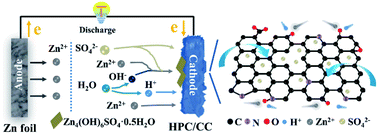A N, O co-doped hierarchical carbon cathode for high-performance Zn-ion hybrid supercapacitors with enhanced pseudocapacitance†
Abstract
Zn-ion hybrid supercapacitors (ZHSs) are an advanced energy storage system with high energy/power density. However, the development of cathodes with high-performance is still a challenge. Herein, N, O co-doped hierarchical porous carbon (HPC) integrated with carbon cloth (CC) was fabricated as a promising cathode for aqueous ZHSs, which delivered a high specific capacity of 138.5 mA h g−1 with excellent rate performance ( 75 mA h g−1 at 20 A g−1) and superb cycling stability without decay after 10 000 cycles. As a result, an exceptionally high energy density of 110 W h kg−1 and attractive power density of 20 kW kg−1 can be obtained. More importantly, the dual cation (H+ and Zn2+) chemical absorption process for additional capacity is firstly proposed and verified by ex situ experiments, while the precipitation/dissolution process of zinc hydroxide sulphate hydrate is explained. Furthermore, a quasi-solid-state HPC/CC-based ZHS device based on gel electrolyte also showed promising potential for practical applications. This work provides a new pathway to develop carbon-based cathode materials for sustainable ZHSs.



 Please wait while we load your content...
Please wait while we load your content...